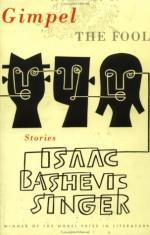|
This section contains 4,822 words (approx. 17 pages at 300 words per page) |

|
SOURCE: Clasby, Nancy Tenfelde. “Gimpel's Wisdom: I. B. Singer's Vision of the ‘True World’.” Studies in American Jewish Literature 15 (1996): 90-98.
In the following essay, Clasby considers the connection between the archetypal images of the scapegoat and the trickster or fool and traces Gimpel's journey to wisdom in “Gimpel the Fool.”
Isaac Bashevis Singer's “Gimpel the Fool” is the tale of a gullible baker, his faithless wife, and the devil who tempts the baker to settle old scores. Singer's theme is that of the wise fool,1 a common figure in literature, but always a bit of an enigma. The fool is a catalyst for reversals and surprises. Gimpel, the fool of Frampol, becomes a prophet, and his unfaithful wife is transformed into a figure of wisdom, holy Sophia. Our expectations, like those of the sages of Frampol, are derailed by the paradoxes of contradictory wisdom. Underlying the tales's crosscurrents...
|
This section contains 4,822 words (approx. 17 pages at 300 words per page) |

|


